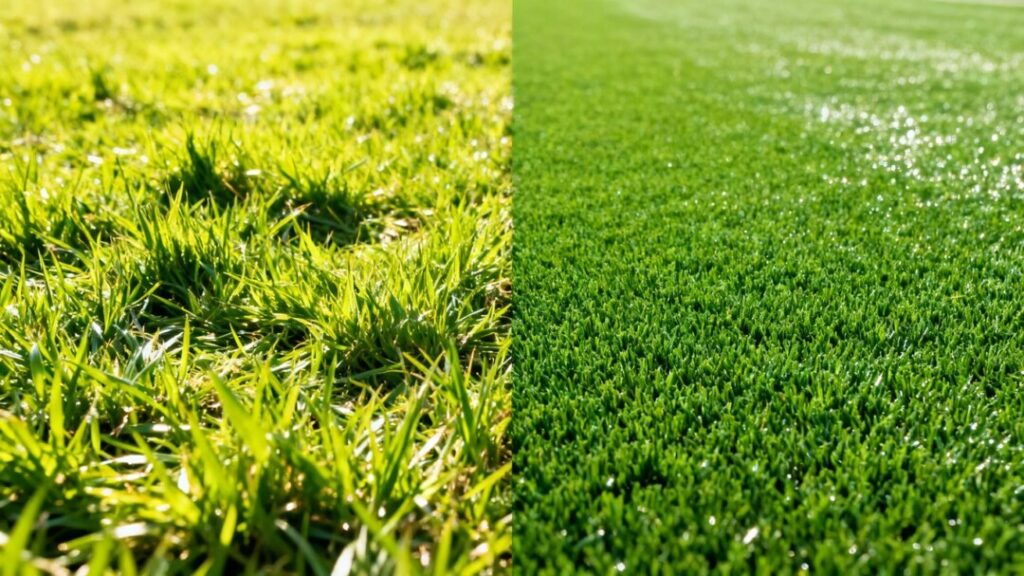As homeowners increasingly seek low-maintenance landscaping solutions, artificial grass, or turf, has emerged as a popular alternative to traditional lawns. This synthetic surface mimics natural grass and offers a convenient option for those tired of constant upkeep. However, before making the switch, it’s crucial to understand the advantages and disadvantages it presents.
Key Takeaways
- Artificial grass offers a low-maintenance, consistently green lawn but comes with a significant upfront cost and potential heat issues.
- Different types of turf exist, varying in durability and softness, with nylon, polyethylene, and polypropylene being common.
- While generally safe, concerns exist regarding older or cheaper products and certain infill materials.
What is Artificial Grass?
Artificial grass, also known as synthetic turf or fake grass, is a man-made surface crafted from synthetic fibers stitched into a backing material. It’s designed to replicate the appearance and feel of natural grass. The surface is often infilled with materials like sand or rubber to help the blades stand upright and provide support. Initially developed for sports fields, it’s now widely adopted for residential and commercial landscaping.
Types of Artificial Turf
- Nylon Turf: Highly durable and stiff, suitable for high-traffic areas and sports. It’s more expensive and less soft than other options.
- Polyethylene Turf: Offers a soft, realistic feel with good durability, making it ideal for residential lawns, backyards, and pet areas. It may wear faster in high-traffic zones.
- Polypropylene Turf: The least durable but most affordable option, best for low-traffic or decorative areas. Not recommended for frequent foot traffic or pets.
The Pros of Artificial Grass
- Low Maintenance: Eliminates the need for mowing, edging, watering, and fertilizing.
- Water Savings: Significantly reduces water consumption, especially beneficial in drought-prone regions.
- Year-Round Greenery: Maintains a lush, green appearance regardless of weather conditions.
- Pet-Friendly: Easy to clean and resistant to stains and odors.
- Safe for Children: Provides a soft, cushioned surface suitable for play areas.
- No Allergens: Does not produce pollen, offering relief for allergy sufferers.
- Improved Drainage: Modern systems prevent puddles and promote quick drying.
The Cons of Artificial Grass
- High Upfront Cost: Installation can range from $8 to $20 per square foot.
- Surface Heat: Can become uncomfortably hot under direct sunlight.
- Potential for Damage: Vulnerable to damage from fireworks, grills, sharp objects, and heavy furniture.
- Environmental Impact: Made from plastic and is not biodegradable.
- Installation Disruption: Requires removal of existing lawn and ground leveling.
- Not Maintenance-Free: Needs occasional cleaning, brushing, and infill replenishment.
Is Artificial Grass Toxic?
Most modern artificial grass products are considered safe for people and pets, especially when sourced from reputable manufacturers adhering to safety standards. Common materials like polyethylene and polypropylene are non-toxic. Lead-free options and natural infills (sand, coconut fibers) are preferable. However, older or cheaper products might contain heavy metals or chemicals like PFAS, and crumb rubber infill (from recycled tires) can release VOCs. Always inquire about product safety certifications and opt for lead-free, PFAS-free, and pet-safe options with natural infill.
Is Artificial Grass Right for You?
Artificial grass can be an excellent choice for those prioritizing a low-maintenance, consistently attractive lawn, particularly in high-traffic or pet-friendly areas. However, if you enjoy gardening, the scent of fresh-cut grass, or supporting pollinators, natural grass might be a better fit. Ultimately, both real and artificial grass require some level of maintenance.


